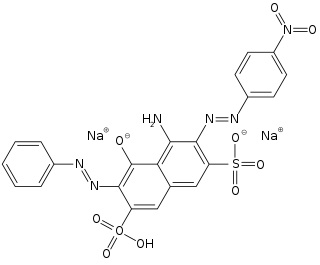Amido black 10B
 | |
 | |
| Names | |
|---|---|
| IUPAC name
Sodium 4-amino-5-hydroxy-3-((E)-(4-nitrophenyl)diazenyl)-6-((E)-phenyldiazenyl)naphthalene-2,7-disulfonate | |
| Other names
4-Amino-5-hydroxy-3-[(4-nitrophenyl)azo]-6-(phenylazo)-2,7-naphthalene disulfonic acid, disodium salt Amidoschwarz Naphthol blue black Acid Black 1 Acidal Black 10B Acidal Navy Blue 3BR Naphthalene Black 10B Buffalo Black NBR C.I. 20470 | |
| Identifiers | |
3D model (JSmol) |
|
| ChEBI | |
| ChemSpider | |
| ECHA InfoCard | 100.012.640 |
PubChem CID |
|
| UNII | |
| |
| |
| Properties | |
| C22H14N6Na2O9S2 | |
| Molar mass | 616.49 g·mol−1 |
| Appearance | Dark red to black |
| ~ 30 g/l at 20 °C (68 °F) | |
| Hazards | |
| R-phrases (outdated) | R20, R21, R33 |
| S-phrases (outdated) | S28A, S37, S45 |
| NFPA 704 | |
Except where otherwise noted, data are given for materials in their standard state (at 25 °C [77 °F], 100 kPa). | |
| Infobox references | |
Amido black 10B is an amino acid staining azo dye used in biochemical research to stain for total protein on transferred membrane blots, such as the western blot. It is also used in criminal investigations to detect blood present with latent fingerprints. It stains the proteins in blood a blue-black color. Amido Black can be either methanol or water based as it readily dissolves in both. With picric acid, in a van Gieson procedure, it can be used to stain collagen and reticulin.
See also
References
- ↑ "AMIDO BLACK 10B". chemicalland21.com. Retrieved December 2, 2017.
External links
This article is issued from
Wikipedia.
The text is licensed under Creative Commons - Attribution - Sharealike.
Additional terms may apply for the media files.
